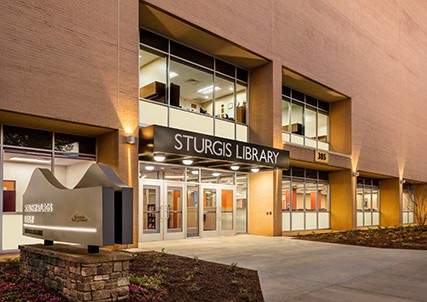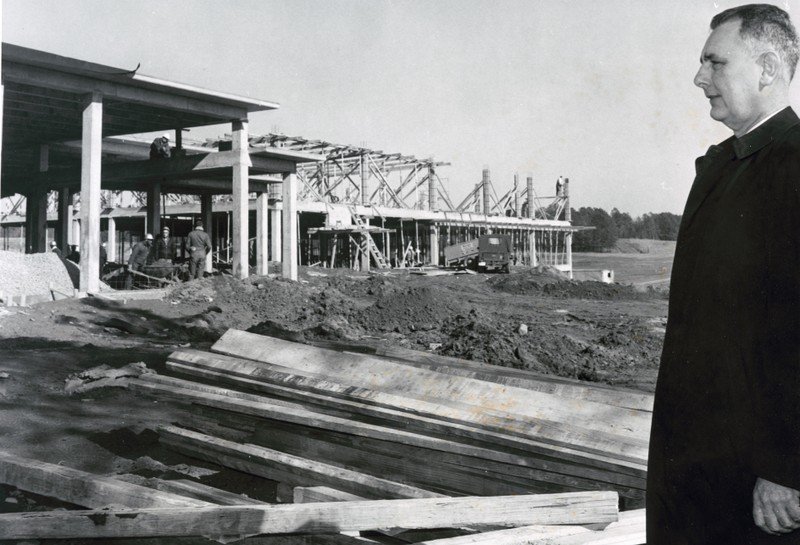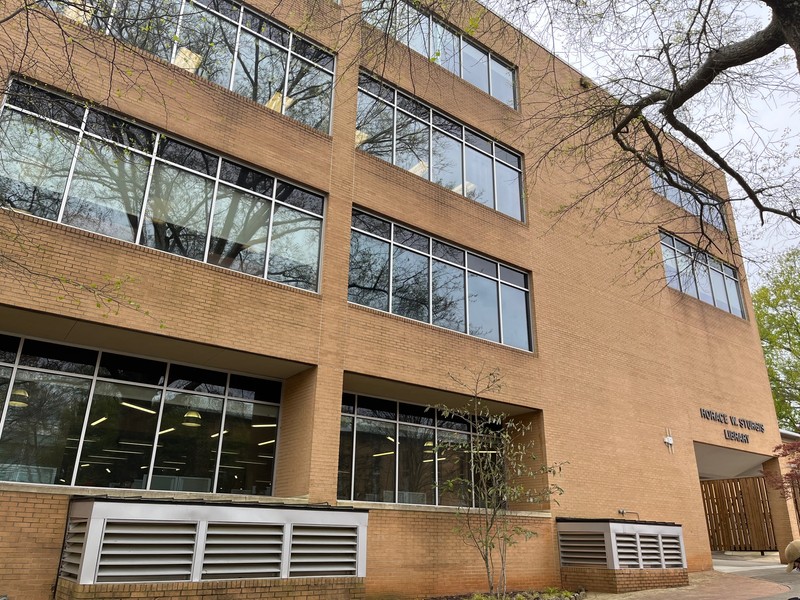Horace W. Sturgis Library, Kennesaw State University
Introduction
Text-to-speech Audio
Built in 1981 as part of Kennesaw College, this library was originally named the Kennesaw Library. It was constructed in order to meet the demands of the growing college. Covering over 100,000 square feet, this new library could hold over 300,000 volumes and accommodate nearly 1,000 students, compared to the original library which held 85,000 volumes, was only 20,000 square feet, and could accommodate roughly 400 students. Upon its completion, the Kennesaw Library replaced the significantly smaller library, now the Pilcher Public Service Building, that was built in 1967 as part of the original eight buildings that made up the Kennesaw Junior College campus. In 1990, the new Kennesaw Library was renamed the Horace W. Sturgis Library in honor of the College's first president.
Images
The Horace W. Sturgis Library

The original library of Kennesaw Junior College, now the Pilcher Public Service Building, pictured in 1968.
.jpg)
Dr. Horace W. Sturgis, Kennesaw College's first president, overseeing the construction of the library that would come to bear his name

Sturgis Library, 2023

Backstory and Context
Text-to-speech Audio
The Sturgis Library, built on the campus of Kennesaw College, now Kennesaw State University, in 1981, was not the first library built on the campus. The original library, now the Pilcher Public Service building, was constructed in 1967 as part of the original eight buildings of Kennesaw Junior College. Upon its opening on March 16, 1967, it boasted a collection of 4,200 books and was expected to have a collection of approximately 7,000 by June 1967. The Sturgis Library, originally called the Kennesaw Library, was constructed as a means of accommodating the growing number of students attending Kennesaw College and utilizing its resources. This new five-story library, which covered 100,000 square feet, was built to hold over 300,000 volumes and accommodate nearly 1,000 students at a time. This compares to the Kennesaw Junior College library which could hold 85,000 volumes and accommodate roughly 400 students with only 20,000 square feet.
With the construction of the Sturgis Library, the old library’s new function had yet to be determined. Initially, it was thought that the old library would become a Media Center or a location for larger classrooms. On June 8, 1987, the old library was officially renamed the W. Wyman Pilcher Public Service Building and today is home to the Department of World Languages and Cultures as well as the Foreign Language Resource Collection. The two buildings were originally connected, with an enclosed walkway between them, so as to afford handicapped students better access to both buildings. This walkway was removed in 2016 when the Sturgis Library underwent a $4.4 million dollar renovation to its ground and first floors. After the renovation, the Sturgis Library and the Pilcher Public Service building were separated and became two distinct buildings, as they remain today.
The Kennesaw Library was renamed the Horace W. Sturgis Library in honor of the University’s first president, Dr. Horace W. Sturgis, after his death in 1990. Dr. Sturgis was born on May 12, 1912, in Grand Valley, Pennsylvania. In 1935, he graduated from Piedmont College with a bachelor's Degree in chemistry. He went on to become a teacher at Fayetteville High School as well as principal of Eatonton High School. In 1940, after marrying his wife, Sue Cowan, he moved to Atlanta where he taught at North Fulton High School. During World War Two, Sturgis left his teaching career in order to join the war effort. He joined the staff at Georgia Tech as an instructor of the War Training Program in 1942. In 1943, he took up the role of director of the Ground School of Aviation at the University of Georgia until he returned to Georgia Tech to serve as a physics instructor until 1945. At that time, he joined the Navy. After the war and with a glowing reputation, Sturgis was promoted to assistant professor at Georgia Tech in 1946. In 1947, he was made assistant registrar. In 1958, he earned his Ph.D. from New York University. His academic career further blossomed when he was appointed founding president of the new Kennesaw Junior College on July 1, 1965. Dr. Sturgis has been credited with raising the school's academic reputation and earning the Junior College the four-year status that its students desperately desired, transforming the school into Kennesaw College in 1976. After 15 years as the college’s president, Dr. Sturgis retired on March 9, 1981, and was succeeded by Dr. Betty L. Siegel, the college’s first female president. Dr. Sturgis’s retirement coincided perfectly with the completion of the library that would one day bear his name in honor of his role as the University’s first president.
Sources
Daves, Susan, “New Library Stacks Up at Kennesaw,” The Sentinel, Spring Quarter, 1981, The Sentinel student newspaper collection, KSU/51/01, Kennesaw State University Archives.
Northcutt, Lynn, “New Library Opens,” The Sentinel, April 7, 1967, The Sentinel student newspaper collection, KSU/51/01, Kennesaw State University Archives.
Scott, Thomas Allan. KSU/SPSU History Timeline, 1947-2016. Thomas Scott Collection, Bulk 1975-2005, KSU/45/05/003, Kennesaw State University Archives.
Sentinel Staff, “President Sturgis Gets KJC Off the Ground,” The Sentinel, April, 1982, The Sentinel student newspaper collection, KSU/51/01, Kennesaw State University Archives.
Siegel, Betty L. Kennesaw State University: Commemorating 35 Years of History, 1998, Kennesaw State University Relations, 2020-012-ks, Kennesaw State University Archives.
Slutskaya, Sofia. “Kennesaw State University Library System IN THE SPOTLIGHT!” Georgia Library Association, January 11, 2019. https://gla.georgialibraries.org/kennesaw-state-library-system-in-the-spotlight/#:~:text=In%202016%2C%20the%20Sturgis%20Library,updated%20mechanical%20and%20security%20systems.
Kennesaw State University
KSU archives
KSU archives
Elizabeth Rosser
